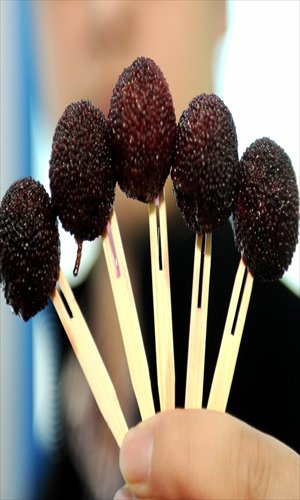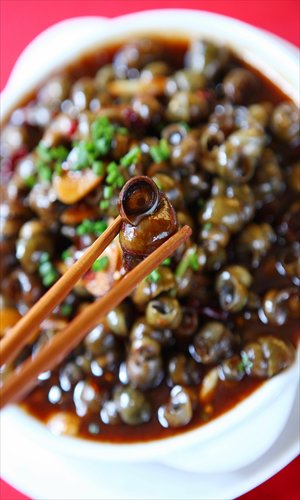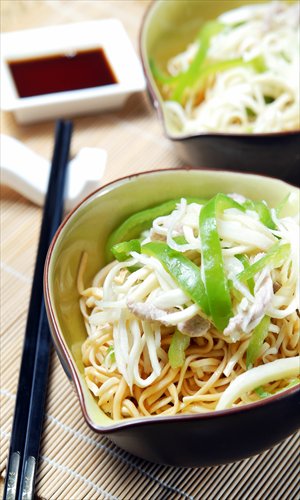A Taste of Summer
Editor's note
The ancient Chinese created an agricultural solar system - still in use today - that is based upon their observation of crops, climate, astrology, and the study of animal and plant life cycles. The system guided farmers as to when to sow seeds and when to harvest them, and this system has now been in place for more than 2,000 years.
Today, with advances in science and technology, agriculture depends less on this ancient wisdom. But this seasonal calendar still operates as a reference guide for gourmands to seek out the best times for seasonal delicacies and for health experts to plan nutritious diets.
In a single year, the system features 24 "solar terms," each lasting one day and occurring every two weeks. Each has its own name and characteristics. The Global Times is presenting a weekly series examining which foods and delicacies are best enjoyed during these periods, as well as tips on preserving general health.
The summer solstice (which falls tomorrow this year) is the day when people living in the northern hemisphere enjoy the earliest sunrise and the latest sunset of the year. According to the ancient Chinese Book of Rites (which recorded customs in the country before the Han Dynasty 206BC-220AD) when the summer solstice arrives, cicadas start to sing, and hibiscuses are in full bloom. In Chinese the term is xiazhi, which literally means "summer is coming."
The summer solstice is recognized as one of the earliest festivals ever celebrated by Chinese people. Although the summer solstice is no longer a festival or national holiday, people still maintain certain traditions in marking the day, especially that of serving particular foods. The Global Times has picked out some culinary delights typical to the Yangtze River Delta region during the summer solstice.

Waxing lyrical
As a popular saying goes, the summer solstice signals the harvesting of waxberries (yangmei) and, as time moves on, the waxberries are likely to be infested with worms. The saying is a reminder that this is the time to enjoy the sweetness of waxberries.
Usually waxberries are eaten raw after thorough washing. It is best to steep them in salted water for half an hour and then rinse them with fresh water. But there are other ways to delight your taste buds with waxberries. The following recipe is for waxberry syrup.
Ingredients: 500 grams waxberries, 50 grams crystal sugar and two tablespoons malt sugar
Method:
Clean the waxberries thoroughly and bring to the boil with the crystal sugar over a medium heat
When the water starts to boil, turn the heat down, and simmer for 10 minutes
Add the malt sugar to the mixture and turn off the heat when the malt sugar is completely melted
Let the syrup cool down naturally, and then refrigerate before serving

Snails' pace
"Summer is a great time to enjoy the field snails commonly found in the Yangtze River Delta region," said Jiang Chuanjun, an experienced cook at the city's Zui Shanghai restaurant. Although field snails are available throughout the summer and autumn, their taste is affected once they start to produce eggs later in the summer.
According to the Compendium of Materia Medica compiled by Li Shizhen during the Ming Dynasty (1368-1644), field snails are "cold" in nature. So eating field snails in summer is helpful in dispelling inner "heat," which also helps to remove dampness from the body as well as improving a person's eyesight. Jiang offers Global Times readers the following cooking method.
Ingredients: 500 grams field snails, 15 grams hot pepper, 10 grams spring onions, 10 grams ginger, 20 grams garlic, three tablespoons sugar, three tablespoons salt, one tablespoon white spirit and four tablespoons dark soy sauce
Method:
Steep the field snails in water for at least 5 hours, in order to get rid of the dirt and sand lodged inside them
Cut the spring onions into pieces, the ginger into threads, and the garlic into slices
Stir-fry the hot pepper, green onions, ginger and garlic on a high heat, then add the field snails and fry until the skin-like shells of the snails begin to open
Add salt, white spirit, dark soy sauce, sugar and boiling water, and stew until the water is dried out, and serve

Chill out with noodles
As another popular saying goes, the daytime will get shorter after you've eaten noodles at summer solstice. Many restaurants in the city offer a wide range of cold noodle dishes, and the Global Times has found a typical recipe: cold noodles with sesame sauce.
Ingredients: 250 grams thin noodles, 50 grams mung bean sprouts, one tablespoon sesame sauce, one tablespoon peanut butter, 1/4 tablespoon salad oil, one tablespoon sugar, two tablespoons soy sauce, 1/8 tablespoon salt, one tablespoon vinegar, two tablespoons chili oil and 60 milliliter boiling water
Methods:
Mix the sesame sauce and peanut butter with boiling water, and then add sugar, soy sauce, vinegar and chili oil into the mixture
Boil the noodles, then dip them in cold water for a few seconds, and then drain the water
Add the peanut or bean oil to the noodles to stop the noodles sticking together
Scald the mung bean sprouts in the noodle soup, and pick them out
Mix the cold noodles with mung bean sprouts and the prepared sauce, and serve